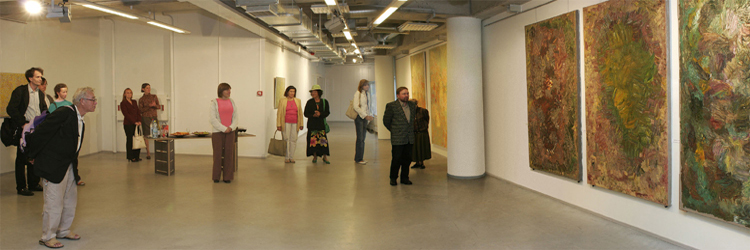Could a Galactic Catastrophe Be Beautiful? : Ove Büttner, an Earnest Artist
The world of Ove Büttner still consists of two clearly distinguishable poles. Every magic sign on the canvas conceals a certain meaning on the idealistic level. During the last year those two sides have been developing towards greater independency and their disconnection could be spoken about, except the artist lays stress on his works' internal intrigue and imposes them in epic series. Büttner is also prone to verbally mediate the message of his next show. The birth and apocalypse of worlds, the temporal limits for existence, galactic processes and collapses, comparisons with the Phoenix rising from ashes, and the struggle between entropy and negentropy - these are the keywords of his exhibit in Tallinn Town Prison Museum.
However, we cannot find anything visually dramatic here. From the beginning of the exhibition (pro imaginary universes) up to its end, the colours communicate according to all the rules of harmony and converge in peaceful compositions through tempered intensity. Possibly everybody are not convinced of such descriptions of the apocalypse. Could a galactic catastrophe be beautiful? It is apparently dependent on one's point of view, one's grounds. If there is a painter's grounds, then Ove Büttner has never diverged from it. Already his show of some years before in Tallinn Art Hall Gallery, where he treated rather harsh political and social themes, proved that we are dealing with a man who filters even the most prosaic matters of life through harmonies of colour and only then fixates them on canvases. Now we also see that, for instance, collisions related to the end of the world, though schizophrenically sharp yellow, have been converged into centrally rotating compositions and "good-neighbourly" tonalities. The apocalypse itself ("The Collapse") is also surrounded by an eye-friendly green pattern and has a harmless effect as a natural course of matters. What kind of impression has "looking through flowers" (there are a lot of flower motifs used in the show) in modern young art? I have seen senior colleagues negligence, saying: now the youth has discovered pattern-painting for themselves (pro invented the bicycle)! It is true, Büttner does not trouble himself with coining revolutionary inventions, and is, from this aspect, a typical representative of younger generation. Nevertheless, there is something conservative about him that approximates him to the romantic imagination of the artist as an earnest holy man who has been blessed with divine spark. We cannot find a single sign of the artist's inner weaknesses, the desire to giggle at himself or his doings or to turn the matter into a farce, decadence or an art-historical parody in Büttner's works as it is frequently met in the works of the artist under 30 years of age today. The holy man leaves the mockery of the world to others. Hence, in this meaning, nothing specific for modern youth, but just one of the archetypes that stretches over times.
